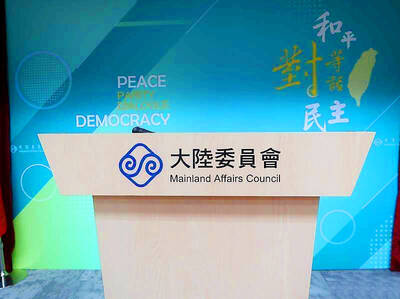The US Federal Reserve’s move to match its historic low in interest rates along with a downbeat economic outlook suggests the central bank is girding for more actions to stave off a crippling deflationary threat, analysts said.
The Fed cut its key lending rate a half point on Wednesday to 1 percent in the latest action to ease a credit crisis that is strangling the US economy, but also noted that “downside risks to growth remain” for the world’s biggest economy.
“It is clear that the Fed has moved from a defensive, case-by-case crisis management approach in the summer months to an offensive and comprehensive attack on the deflationary forces in the economy,” said Brian Bethune, chief US economist at IHS Global Insight.

PHOTO: AFP
Bethune predicts the Fed will bring the federal funds rate below the previously unthinkable level of 1 percent despite fears of a Japanese-style deflation threat that is unresponsive to monetary policy.
He said the Fed is likely to cut another 50 basis points on Dec. 16, which would be the lowest since the inception of the funds rate in 1954.
The economist said Fed chairman Ben Bernanke has made it clear he will use all tools at his disposal to break the grip of a worldwide credit crunch.
“The Fed has broadened and amplified its response to the escalation of the financial crisis and the recessionary forces now gaining momentum in the economy.
“In the month of October, the Fed slashed interest rates by 100 basis points, and also committed to close to US$2 trillion of additional short-term lending in the next few months,” he said. “That is a massive commitment to unlocking the credit markets.”
In 2003 and 2004, the Fed did not go below 1 percent amid concerns about how low rates could hurt small investors and money market funds.
But Peter Kretzmer, senior economist at Bank of America, pointed out that the latest statement “said nothing that would indicate technical issues preventing it from lowering rates further.”
The cut in the federal funds rate, which impacts on a number of other borrowing rates, followed an emergency half-point cut on Oct. 8 coordinated with other central banks to help fight a worldwide credit crunch.
“The pace of economic activity appears to have slowed markedly, owing importantly to a decline in consumer expenditures,” said the Federal Open Market Committee (FOMC) after the unanimous decision widely expected by financial markets.
Some analysts said the glum tone of the statement suggested the Fed could cut rates further, but would likely await the impact of its actions because of potential dangers of lowering its base rate below 1 percent — the level in 2003 and 2004 that likely fueled the US housing boom-and-bust cycle.
The statement “opens the door to more easing if incoming data continue to deteriorate,” said Aaron Smith, an analyst at Moody’s Economy.com.
Cary Leahey, senior economist at Decision Economics, said the FOMC “was reluctant to lower rates further than 1.0 percent but they did say that downside risks remain.”
This suggests “they want to wait till the next meeting before cutting again,” he said.
“The Fed doesn’t want to be caught in a trap of leaving rates too low too long.” Leahey said. “There is also a feeling they want to keep their powder dry.”

MORE VISITORS: The Tourism Administration said that it is seeing positive prospects in its efforts to expand the tourism market in North America and Europe Taiwan has been ranked as the cheapest place in the world to travel to this year, based on a list recommended by NerdWallet. The San Francisco-based personal finance company said that Taiwan topped the list of 16 nations it chose for budget travelers because US tourists do not need visas and travelers can easily have a good meal for less than US$10. A bus ride in Taipei costs just under US$0.50, while subway rides start at US$0.60, the firm said, adding that public transportation in Taiwan is easy to navigate. The firm also called Taiwan a “food lover’s paradise,” citing inexpensive breakfast stalls

TRADE: A mandatory declaration of origin for manufactured goods bound for the US is to take effect on May 7 to block China from exploiting Taiwan’s trade channels All products manufactured in Taiwan and exported to the US must include a signed declaration of origin starting on May 7, the Bureau of Foreign Trade announced yesterday. US President Donald Trump on April 2 imposed a 32 percent tariff on imports from Taiwan, but one week later announced a 90-day pause on its implementation. However, a universal 10 percent tariff was immediately applied to most imports from around the world. On April 12, the Trump administration further exempted computers, smartphones and semiconductors from the new tariffs. In response, President William Lai’s (賴清德) administration has introduced a series of countermeasures to support affected

CROSS-STRAIT: The vast majority of Taiwanese support maintaining the ‘status quo,’ while concern is rising about Beijing’s influence operations More than eight out of 10 Taiwanese reject Beijing’s “one country, two systems” framework for cross-strait relations, according to a survey released by the Mainland Affairs Council (MAC) on Thursday. The MAC’s latest quarterly survey found that 84.4 percent of respondents opposed Beijing’s “one country, two systems” formula for handling cross-strait relations — a figure consistent with past polling. Over the past three years, opposition to the framework has remained high, ranging from a low of 83.6 percent in April 2023 to a peak of 89.6 percent in April last year. In the most recent poll, 82.5 percent also rejected China’s

PLUGGING HOLES: The amendments would bring the legislation in line with systems found in other countries such as Japan and the US, Legislator Chen Kuan-ting said Democratic Progressive Party (DPP) Legislator Chen Kuan-ting (陳冠廷) has proposed amending national security legislation amid a spate of espionage cases. Potential gaps in security vetting procedures for personnel with access to sensitive information prompted him to propose the amendments, which would introduce changes to Article 14 of the Classified National Security Information Protection Act (國家機密保護法), Chen said yesterday. The proposal, which aims to enhance interagency vetting procedures and reduce the risk of classified information leaks, would establish a comprehensive security clearance system in Taiwan, he said. The amendment would require character and loyalty checks for civil servants and intelligence personnel prior to